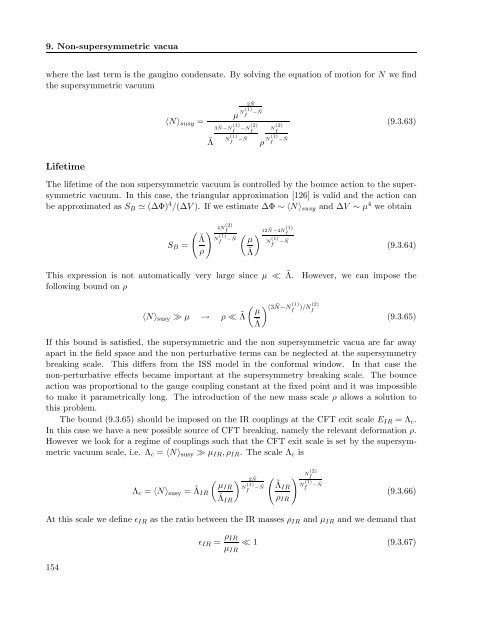Perturbative and non-perturbative infrared behavior of ...
Perturbative and non-perturbative infrared behavior of ...
Perturbative and non-perturbative infrared behavior of ...
You also want an ePaper? Increase the reach of your titles
YUMPU automatically turns print PDFs into web optimized ePapers that Google loves.
9. Non-supersymmetric vacua<br />
where the last term is the gaugino condensate. By solving the equation <strong>of</strong> motion for N we find<br />
the supersymmetric vacuum<br />
Lifetime<br />
〈N〉susy =<br />
˜Λ<br />
µ<br />
2Ñ N (1)<br />
f −Ñ<br />
3Ñ−N(1) f −N(2)<br />
f<br />
N (1)<br />
f −Ñ<br />
ρ<br />
N (2)<br />
f<br />
N (1)<br />
f −Ñ<br />
(9.3.63)<br />
The lifetime <strong>of</strong> the <strong>non</strong> supersymmetric vacuum is controlled by the bounce action to the supersymmetric<br />
vacuum. In this case, the triangular approximation [126] is valid <strong>and</strong> the action can<br />
be approximated as SB ≃ (∆Φ) 4 /(∆V ). If we estimate ∆Φ ∼ 〈N〉susy <strong>and</strong> ∆V ∼ µ 4 we obtain<br />
SB =<br />
˜Λ<br />
ρ<br />
4N(2)<br />
f<br />
N (1)<br />
f −Ñ<br />
µ<br />
˜Λ<br />
12Ñ−4N(1) f<br />
N (1)<br />
f −Ñ<br />
(9.3.64)<br />
This expression is not automatically very large since µ ≪ ˜ Λ. However, we can impose the<br />
following bound on ρ<br />
〈N〉susy ≫ µ → ρ ≪ ˜ Λ<br />
(3Ñ−N<br />
µ<br />
˜Λ<br />
(1)<br />
f )/N(2)<br />
f<br />
(9.3.65)<br />
If this bound is satisfied, the supersymmetric <strong>and</strong> the <strong>non</strong> supersymmetric vacua are far away<br />
apart in the field space <strong>and</strong> the <strong>non</strong> <strong>perturbative</strong> terms can be neglected at the supersymmetry<br />
breaking scale. This differs from the ISS model in the conformal window. In that case the<br />
<strong>non</strong>-<strong>perturbative</strong> effects became important at the supersymmetry breaking scale. The bounce<br />
action was proportional to the gauge coupling constant at the fixed point <strong>and</strong> it was impossible<br />
to make it parametrically long. The introduction <strong>of</strong> the new mass scale ρ allows a solution to<br />
this problem.<br />
The bound (9.3.65) should be imposed on the IR couplings at the CFT exit scale EIR = Λc.<br />
In this case we have a new possible source <strong>of</strong> CFT breaking, namely the relevant deformation ρ.<br />
However we look for a regime <strong>of</strong> couplings such that the CFT exit scale is set by the supersymmetric<br />
vacuum scale, i.e. Λc = 〈N〉susy ≫ µIR,ρIR. The scale Λc is<br />
Λc = 〈N〉susy = ˜ ΛIR<br />
µIR<br />
˜ΛIR<br />
2 Ñ<br />
N (1)<br />
f −Ñ<br />
˜ΛIR<br />
ρIR<br />
N(2)<br />
f<br />
N (1)<br />
f −Ñ<br />
(9.3.66)<br />
At this scale we define ǫIR as the ratio between the IR masses ρIR <strong>and</strong> µIR <strong>and</strong> we dem<strong>and</strong> that<br />
154<br />
ǫIR = ρIR<br />
µIR<br />
≪ 1 (9.3.67)
















